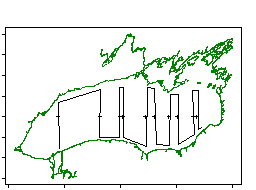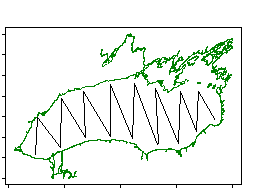
Layout - Parallel transect location is determined by randomly selecting nearshore starting points on the map. Number of transects (sampling effort) is determined based on variance calculations, time constraints, or degree of coverage for pilot studies. This design, although not as statistically efficient as the others discussed below, relies on the most general set of assumptions and thus, as the name would imply, is the simplest statistically to implement.
Advantages and limitations - The simple nature of this design facilitates both implementation and analysis. However, with this simplicity often comes a loss of statistical efficiency, in the sense that the long-term variance will tend to be higher than it would under some other survey design, such as stratified or systematic sampling. Scientists employing a random sampling approach often falsely assume that a sample taken in any one year might be biased because, by chance, several of the transects fall into high density (or alternatively low density) areas thus causing the estimates to be higher or lower than average for that year. But this is not bias, at least not in the long run, because chances are, over many surveys, the resulting estimates will be distributed around the true mean. So don’t mistake variation for bias. Finally, note that the degree to which the efficiency of the random sampling approach will depend on the degree variation (patchiness) of the system being surveyed.
Analyses - Simple random sampling typically treats the transect as the elementary sampling unit upon which a classical analysis is conducted (see below). With fixed integrated intervals along the transect (defined as the elementary sampling unit) analysis might also be conducted using a cluster sampling or a geostatistical approach.
Layout - Parallel transects are evenly spaced across the sampling frame. Number of transects (sampling effort) is determined based on variance calculations, time constraints, or degree of coverage for pilot studies. This design is appropriate if we anticipate no periodicity in distribution during our survey. It is hard to imagine a periodicity in the fish distributions that would be of the same scale as the spatial distance between transects. Therefore this design is currently favored in many systems because of guaranteed better coverage than randomly allocated transects.
Advantages and limitations - This design spreads sampling effort evenly and may be logistically uncomplicated to carry out.
Analyses - Survey data from this design may be analyzed using classical, geostatistical or cluster sampling approach.
Layout - Parallel transects are placed (randomly or systematically) within regions that are expected to have higher variability or where the means may be different. Stratification can be based on bathymetric criteria (e.g., shallower and deeper than a given depth contour) or regionally (e.g., east versus west, bays versus open water). Number of transects (sampling effort) is determined based on variance calculations, time constraints, or degree of coverage for pilot studies.
Advantages and limitations - This design will reduce overall variance by stratifying regions into more homogenous areas.
Analyses - Data from stratified surveys may use classical, geostatistical, or cluster sampling approaches.

Layout - Parallel zigs and parallel zags are distributed throughout the sampling frame. Placement is generally systematic (evenly spaced) with a fixed or random transect start.
Advantages and limitations - This survey type appears to maximize the amount of transect sampling time relative to transit time, but if you are planning to use one of the classical analysis methods (for example, an analysis assuming random sampling) then you may have to utilize only every other transect, thus decreasing the effectiveness of the survey by half. A geostatistical analysis, however, would allow one to use all the data available, provided one is willing to use a model-based approach. The reason for this difference in how the data may be used is that the zig-zag design results in sections of one transect being highly correlated to that of the adjacent transect at the intersecting vertices. Leaving out every other transect diminishes the effect of this small-scale correlation and makes the analysis amenable to analysis under classic designs. Leaving them in provides a mechanism for better characterizing small-scale variation as it is used in a geostatistical analysis.
Analyses - Geostatistical approaches are typically applied for this type of design, thus all the data are utilized (i.e., both zigs and zags). Alternatively, a classical or cluster sampling approach may be applied to alternate parallel transects. It is due to the spatial autocorrelation of data near the intersection of zigs and zags, that only the zigs or the zags, but not both, may be accommodated by a classical or cluster sampling approach. Having the zigs and zags overlap upon replication is another factor complicating classical analyses, which assumes independence in how the samples are allocated. As a result, only half the collected data gets used in the classical approach applied to this type of design, and so there is reduced statistical efficiency relative to the amount of effort used.